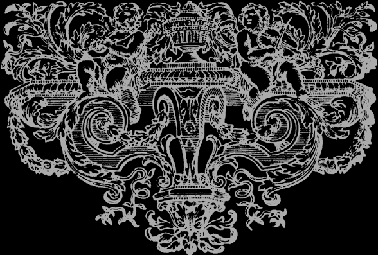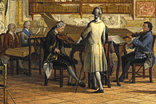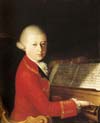N E W 5 - O C T A V E H A R P S I C H O R D S
I N T H E N E A P O L I T A N S T Y L E
General Background Information

The various members of the Mozart family made frequent European tours away from Salzburg in which Leopold, Wolfgang's father, set about to show the world "the miracle which God has let be born in Salzburg". In mid-1763 Leopold obtained a leave of absence from his position as deputy Kapellmeister at the Prince-archbishop's court in Salzburg and the family set out on a prolonged tour. They went to what were then all of the main musical centres of western Europe—Munich, Augsburg, Stuttgart, Mannheim, Mainz, Frankfurt, Brussels, Paris (where they remained for the winter), and then to London (where they spent 15 months). After London Mozart and his family stayed in the Netherlands at the invitation of Caroline, Princess of Nassau Weilburg, from September 1765 to April 1766. In the Hague Nannerl became ill and then later on Wolfgang also fell ill, suffering from typhus. At the request of the Princess both of them were treated by the royal doctor and luckily he was able to cure them both. While in the Netherlands Wolfgang composed no less than twelve musical works, including two symphonies, K.22 and K.45a/A221, and Galli Matthias Musicum, K.32. They returned through Paris, Lyon, and Switzerland, and arrived back in Salzburg in November 1766. After only a little more than nine months in Salzburg, the Mozarts again set out in September 1767, this time for Vienna where, apart from a 10-week break during a smallpox epidemic, they spent 15 months.
Their first 'grand musical tour' to Italy, begun on Dec. 13, 1769 and lasting 15 months, took them to all of the main Italian musical centres although, as usual, they paused at any town where a concert could be given or a nobleman might want to hear Mozart play. In Verona Mozart was put through stringent tests at the Accademia Filarmonica, and in Milan, after tests of his capacities in dramatic music, he was commissioned to write the first opera for the carnival season. After a stop in Bologna where they met the esteemed theorist Giovanni Battista Martini, they proceeded to Florence and on to Rome for Holy Week. There Mozart heard the Sistine Choir in the famous Miserere of Gregorio Allegri (1582–1652), which was considered the choir's exclusive preserve with its own copies of the music jealously guarded from those desiring the music for their own use. However, after hearing the Sistine Choir perform the work only once, Mozart then proceeded to copy out the whole of the music with all of the parts from memory!
The Mozarts then spent six weeks in Naples where they were the guests of the Duke of Hamilton who was himself a violinist and whose first wife Catharine (née Barlow) was an accomplished harpsichord player. Catharine is reputed to have delighted in playing duets on the harpsichord with the young Mozart. The 1766 harpsichord by Burkhat Shudi in the Russell Collection, Edinburgh, is reputed to have belonged to the Hamiltons and to be the instrument that they took with them on their trip to Naples. However, it has now been established by Lillian Cameron (a Friend of St Cecilia's Hall and the Russell Collection) that, although the 1766 Shudi did once belong to a branch of the Hamilton family, the instrument that was owned by Sir William Hamilton in Naples was a different instrument by Burkhat Shudi from that owned by Sir William Hamilton. It was therefore an entirely different instrument that was played by Mozart and Catharine Hamilton.
Mozart playing a concert with the Duke of Hamilton in the Earl of Seaforth's apartments in Naples
Returning through Rome, Mozart had a papal audience and was made a Knight of the Order of the Golden Spur. From that moment Mozart could call himself 'von Mozart', which he did for about a year, but he then later dropped the noble appellation. The summer was passed near Bologna, where Mozart passed the tests for admission to the Accademia Filarmonica at Verona.
In mid-October he reached Milan and
began work on the new opera, Mitridate, rè di Ponto and the premiere at
the Teatro Ducale
in Reggio Emilia on December 26 was a notable success. Mozart, in the traditional way,
directed the first three of the 22 performances. After a brief excursion to
Venice he and his father then returned to Salzburg.
Return to the main 'Mozart' harpsichord design section


